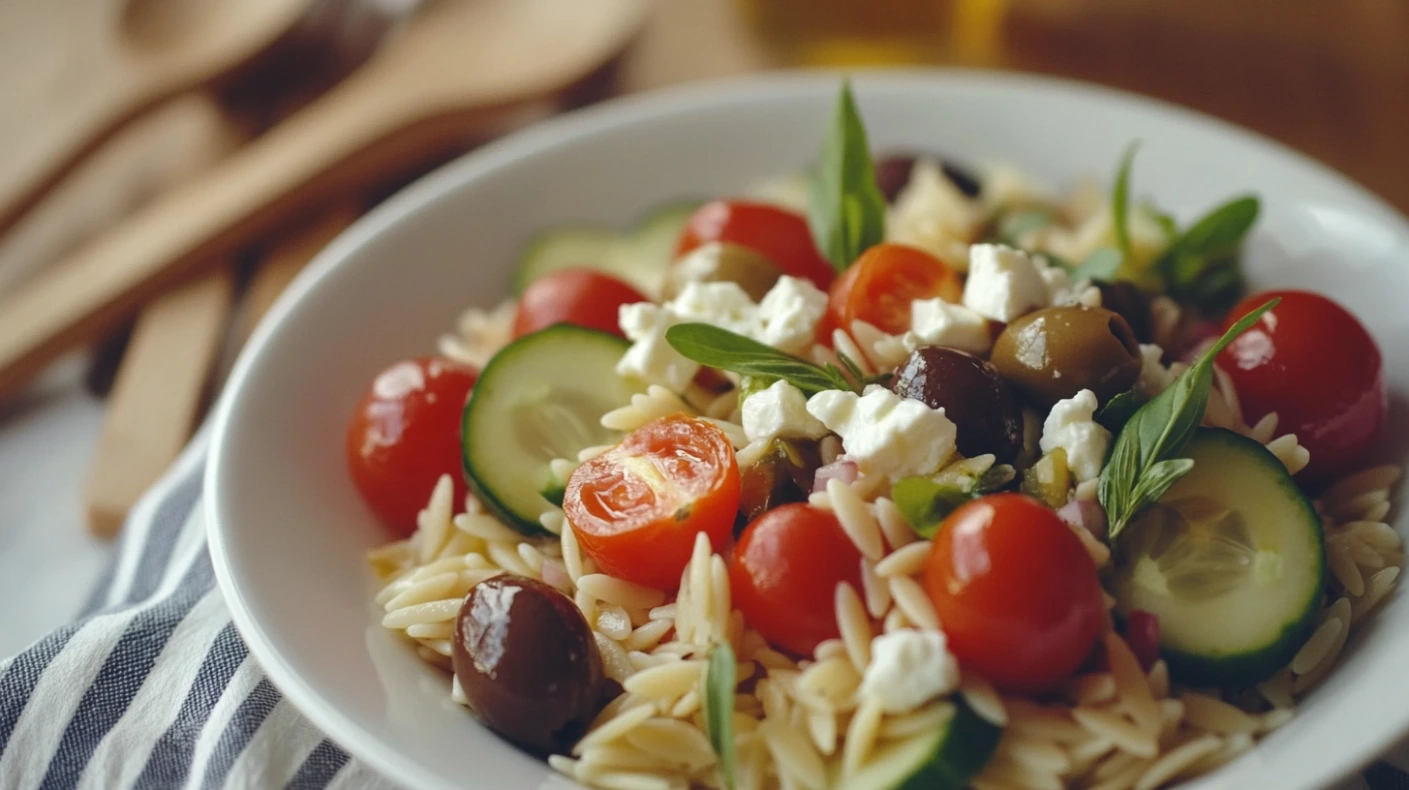What is the Ratio of Water to Orzo When Cooking?
Orzo, often mistaken for rice due to its shape, is a versatile pasta that adds a delightful touch to various dishes. Cooking it perfectly requires understanding the ideal water-to-orzo ratio, which plays a significant role in achieving the right texture and consistency. Whether you’re preparing a warm risotto-style dish or a light pasta salad, nailing this ratio is essential. In this article, we’ll dive deep into the standard water-to-orzo ratio, various cooking methods, and practical tips to troubleshoot common mistakes. Let’s explore how to make the most of this humble yet remarkable ingredient.
Understanding Orzo and Its Cooking Basics
What is Orzo?
Orzo, derived from the Italian word for “barley,” is a type of rice-shaped pasta made from semolina or whole wheat flour. Despite its resemblance to grains, orzo belongs firmly to the pasta family. Thanks to its compact size and neutral flavor, it can effortlessly soak up seasonings and sauces, making it a popular choice in Mediterranean, Italian, and Middle Eastern cuisines.
This versatile pasta finds its way into soups, casseroles, pilafs, and salads. It also works wonders as a side dish, offering a light yet satisfying alternative to traditional pasta or rice.
Why Is the Water-to-Orzo Ratio Important?
The water-to-orzo ratio is the secret sauce to cooking this delicate pasta perfectly. If there’s too much water, orzo can become overly soft and mushy, losing its bite. Too little water, and you’ll risk undercooking or even burning it. By using the proper ratio, you’ll achieve a tender, toothsome texture that complements any dish.
For most recipes, the ideal water-to-orzo ratio is 2:1, meaning two parts water to one part orzo. This ratio allows the pasta to absorb just the right amount of liquid, whether you’re using plain water or a flavorful broth. Understanding this balance is the first step toward mastering orzo in your kitchen.
Orzo in Everyday Cooking
When used correctly, orzo becomes a culinary chameleon. Add it to soups for a hearty boost, toss it in salads for a cold, refreshing dish, or simmer it risotto-style with a splash of white wine and parmesan for a creamy delight. Its ability to adapt makes it a must-have pantry staple.
Stay tuned as we unravel more about cooking methods and tips for achieving the perfect water-to-orzo ratio. In Part 2, we’ll delve deeper into the science of the standard ratio and its variations for different cooking styles.
The Standard Water-to-Orzo Ratio
The Golden Ratio: 2:1
The standard water-to-orzo ratio, 2:1, is key to perfectly cooking this rice-shaped pasta. This means for every cup of dried orzo, you need two cups of water. This ratio ensures that the orzo absorbs enough liquid to cook evenly while maintaining its signature firm yet tender texture.
For those wondering, what is the ratio of water to orzo when cooking?, this golden rule is versatile. Whether you’re preparing orzo as a side dish or the base of a creamy main course, starting with this ratio guarantees consistent results. Adjustments may be needed for specific recipes, but this baseline is universally applicable.
When preparing orzo, choosing between water or broth can elevate the flavor profile. Using chicken or vegetable stock in place of water imparts depth, especially for risotto-style dishes or pilafs. Keep in mind, however, that if your broth contains salt, reduce any additional seasoning to avoid over-salting your dish.
Common Adjustments Based on Cooking Style
Cooking orzo often requires slight tweaks to the standard ratio. For soups, for instance, the ratio might change to accommodate the liquid already present in the dish. Here, adding orzo directly to a simmering broth works well, as the orzo absorbs just enough liquid to soften without losing structure.
Similarly, for cold pasta salads, slightly undercooking the orzo is beneficial. Draining it earlier ensures the pasta holds its shape when mixed with dressings or additional ingredients. This flexibility showcases why orzo is a favorite among chefs and home cooks alike.
Consider exploring this detailed guide to orzo recipes on PenFood to discover creative ways to adapt the water-to-orzo ratio.
Methods of Cooking Orzo with Water
Boiling Method
The boiling method for cooking orzo mirrors that of traditional pasta. Start by bringing a large pot of water to a rolling boil. Though the 2:1 ratio isn’t strictly necessary for this method, ensuring there’s enough water to allow the orzo to move freely is critical. Add a generous pinch of salt to the water before introducing the orzo.
Stir occasionally to prevent sticking, and after about 8-10 minutes, taste test for doneness. When the orzo is tender yet firm, drain it in a colander. Unlike other methods, this approach allows you to cook orzo without worrying about precise liquid absorption.
For best results, toss the drained orzo with a bit of olive oil to prevent clumping. This step is especially useful if the orzo is to be used later in salads or mixed with sauces.

Simmering Method
If you’re asking, what is the ratio of water to orzo when cooking?, the simmering method is where this rule truly shines. Start by heating two cups of water or broth for every cup of orzo. Once the liquid reaches a gentle boil, add the orzo and reduce the heat to low. Cover the pot with a lid to retain the steam.
Simmer for about 10 minutes, checking occasionally. Once the liquid has been absorbed, remove the lid and fluff the orzo with a fork. This method is ideal for dishes where a creamier consistency is desired, as it allows the starches to remain within the dish.
Risotto-Style Cooking
Risotto-style orzo cooking is an indulgent way to enjoy this versatile pasta. Begin by toasting the orzo in butter or olive oil until lightly golden. This step not only enhances the nutty flavor of the pasta but also adds depth to the dish.
Next, gradually add hot water or broth to the pot, one ladleful at a time, stirring constantly. As the liquid absorbs, add more until the orzo reaches your desired texture. This method produces a luxuriously creamy dish without the need for additional cream or cheese.
For a recipe that demonstrates this method beautifully, explore this parmesan-spinach orzo recipe for inspiration.
By using these methods, anyone can master cooking orzo while ensuring it complements a variety of dishes.
Troubleshooting and Common Mistakes
What Happens with Too Much Water?
When cooking orzo, using too much water can dilute the flavor and result in a texture that feels overly soft or mushy. Unlike the boiling method, which doesn’t rely on precise measurements, methods like simmering or risotto-style cooking benefit from adhering to the 2:1 water-to-orzo ratio.
If you accidentally use too much water, don’t panic. Drain the excess liquid promptly, and consider tossing the orzo in a bit of olive oil or butter to restore some richness. This can help prevent clumping and improve the overall taste.
Adding additional ingredients, such as fresh herbs, spices, or a splash of lemon juice, can also brighten the flavor of an overly watered dish. Always taste-test the orzo after adjusting to ensure it’s balanced.
What Happens with Too Little Water?
Using too little water when cooking orzo can lead to unevenly cooked pasta with hard, chewy centers. This issue often arises when the liquid evaporates too quickly or if the pot’s lid isn’t properly sealed during simmering.
If you notice the liquid running low before the orzo is fully cooked, simply add more hot water or broth in small increments. Stirring frequently helps distribute heat evenly, ensuring the orzo cooks to the right consistency.
To avoid this problem in the future, always measure your liquid carefully. If you’re wondering, what is the ratio of water to orzo when cooking?, sticking to the 2:1 ratio as a baseline will save you time and frustration.
For tips on working with orzo in creative ways, consider exploring other orzo-based recipes on the site, such as this culinary exploration of orzo in Italian cuisine.
Frequently Asked Questions (FAQs)
How Do I Adjust the Ratio for Larger Quantities?
Scaling up the 2:1 water-to-orzo ratio is straightforward. For example, if you’re cooking 2 cups of orzo, use 4 cups of water or broth. This consistency ensures the pasta absorbs just enough liquid for even cooking.
For extra-large batches, consider using a larger pot to prevent overcrowding. This helps maintain even heat distribution, reducing the risk of sticky or undercooked orzo.
Can I Use the Same Ratio for Broth or Stock?
Yes, the same 2:1 ratio applies when using broth or stock instead of water. In fact, broth adds a savory depth of flavor that elevates the dish. However, keep in mind that store-bought broths can be salty. Adjust the seasoning accordingly to avoid an overly salty result.
How Do I Know When Orzo Is Cooked Perfectly?
Perfectly cooked orzo is tender but still has a slight bite, much like al dente pasta. Taste-testing during cooking is the best way to determine doneness. If you’re simmering or cooking risotto-style, ensure all the liquid is absorbed for a creamy texture.
If you’re boiling orzo, aim to cook it for 8–10 minutes. Always rinse it briefly with warm water if you’re using it in cold salads to remove excess starch.
What’s the Best Way to Store Leftover Orzo?
Leftover orzo can be stored in an airtight container in the refrigerator for up to three days. Before storing, toss it with a bit of olive oil to prevent clumping. Reheat in the microwave or on the stovetop, adding a splash of water or broth to restore moisture.
For more ideas on how to use leftover orzo, check out this versatile orzo recipe with parmesan and spinach.
By addressing these common questions and troubleshooting tips, you’ll have all the tools you need to cook orzo with confidence.
Creative Uses of Orzo Beyond Basic Cooking
Cold Salads
Orzo shines in cold salads, offering a unique texture that complements fresh vegetables and vibrant dressings. To prepare orzo for a salad, follow the 2:1 water-to-orzo ratio to achieve the perfect texture—firm yet tender. Once cooked, rinse the orzo under cold water to stop the cooking process and remove excess starch.
Combine your cooked orzo with ingredients like cherry tomatoes, cucumbers, olives, and feta cheese for a Mediterranean-inspired dish. Toss with a light vinaigrette made from olive oil, lemon juice, and herbs for a refreshing finish. This method ensures the orzo stays flavorful and doesn’t clump together.
For more inspiration on combining flavors, try experimenting with recipes like spinach orzo. Adjust the dressing to suit your taste or seasonal ingredients.

Soups and Stews
When it comes to soups and stews, orzo is a versatile addition. If you’re wondering, what is the ratio of water to orzo when cooking?, the answer changes slightly in this context. Since orzo will absorb liquid as it cooks, adding it directly to the soup requires careful timing and attention.
Add orzo during the last 10 minutes of simmering to ensure it cooks evenly without becoming overdone. Keep in mind that orzo will continue to absorb liquid even after the soup is removed from heat. If your soup becomes too thick, simply add more broth to balance the consistency.
For rich, hearty soups, consider toasting the orzo lightly in olive oil before adding it to the pot. This step enhances its nutty flavor and adds depth to the dish.
Conclusion and Final Tips
Cooking orzo might seem simple, but understanding the finer details, like the water-to-orzo ratio, can elevate your dishes from good to exceptional. Whether you’re preparing it for a cold salad, a comforting soup, or a risotto-style entrée, sticking to the 2:1 ratio ensures perfect results every time.
Experiment with different methods to discover which works best for your recipes. For example, using broth instead of water not only follows the ratio but also enhances the overall flavor. Additionally, don’t forget to consider how orzo pairs with your other ingredients. A balanced approach will make every dish shine.
Finally, for those seeking more ideas, check out creative orzo recipes and tips from trusted cooking sites. With the right techniques and a bit of practice, orzo can become a staple in your kitchen repertoire.
Customizing Orzo for Special Diets
Gluten-Free Alternatives
For individuals with gluten sensitivities, traditional orzo may not be suitable. However, gluten-free versions made from ingredients like quinoa, corn, or rice are excellent substitutes. When cooking these alternatives, it’s essential to adjust the water-to-orzo ratio, as some gluten-free varieties absorb water differently.
Start with the standard 2:1 ratio and monitor the texture during cooking. If the orzo becomes too soft, reduce the cooking time or the amount of liquid. Adding a flavorful broth instead of plain water can also enhance the taste, making gluten-free options as delicious as traditional orzo.
Vegan-Friendly Preparations
Orzo is a versatile choice for vegan dishes, and it pairs well with plant-based ingredients. When preparing vegan meals, consider using vegetable stock in place of water. This small change adheres to the 2:1 water-to-orzo ratio while adding depth and richness to the dish.
For a quick and nutritious vegan recipe, combine cooked orzo with roasted vegetables, fresh herbs, and a tangy lemon-tahini dressing. This approach not only highlights the orzo but also provides a satisfying, balanced meal.
Pairing Orzo with Global Cuisines
Mediterranean Dishes
Orzo is a staple in many Mediterranean recipes, where it’s often combined with flavors like garlic, lemon, and olive oil. Following the 2:1 water-to-orzo ratio ensures the pasta is perfectly cooked and ready to absorb these bold, bright flavors.
Try incorporating orzo into dishes like Greek salads or as a base for grilled seafood. Topping with crumbled feta and a sprinkle of oregano completes the Mediterranean flair.
Italian-Inspired Recipes
In Italian cuisine, orzo is frequently used in soups and baked dishes. To achieve the best texture, stick to the 2:1 water-to-orzo ratio, especially when simmering the pasta directly in a tomato-based sauce.
For a hearty Italian meal, bake cooked orzo with marinara sauce, mozzarella, and Parmesan cheese. Layer the ingredients in a casserole dish and bake until bubbly. This comforting dish highlights orzo’s versatility and its ability to blend seamlessly with Italian flavors.
By exploring these global cuisines, you’ll see just how adaptable orzo is in the kitchen. Whether you’re creating a vegan meal or a Mediterranean-inspired dish, starting with the right water-to-orzo ratio is the key to success.

